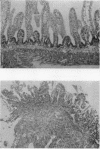Abstract
Human infants are relatively resistant to Clostridium difficile-associated diarrhea and colitis compared to adults. In that toxin A is the major cause of intestinal damage with this organism, we compared toxin A receptor binding and biological effects in newborn vs adult rabbit ileum. Purified toxin A (M(r) 308 kD) was labeled with tritium or biotin with full retention of biologic activity. Appearance of specific toxin A brush border (BB) binding was strongly age dependent with minimal [3H]toxin A specific binding at 2 and 5 d of life, followed by gradual increase in binding to reach adult levels at 90 d. Absence of toxin A binding sites in newborn and presence in adult rabbits was confirmed by immunohistochemical studies using biotinylated toxin A. Toxin A (50 ng to 20 micrograms/ml) inhibited protein synthesis in 90-d-old rabbit ileal loops in a dose-dependent fashion. In contrast, inhibition of protein synthesis in 5-d-old rabbit ileum occurred only at the highest toxin A doses (5 and 20 micrograms/ml) and at all doses tested was significantly less than the adult rabbit ileum. In addition, toxin A (5 micrograms/ml) caused severe mucosal damage in adult rabbit ileal explants but had no discernable morphologic effect on 5-d-old rabbit intestine. Our data indicate that newborn rabbit intestine lacks BB receptors for toxin A. The absence of the high-affinity BB receptor for toxin A in the newborn period may explain lack of biologic responsiveness to purified toxin, and the absence of disease in human infants infected with this pathogen.
Full text
PDF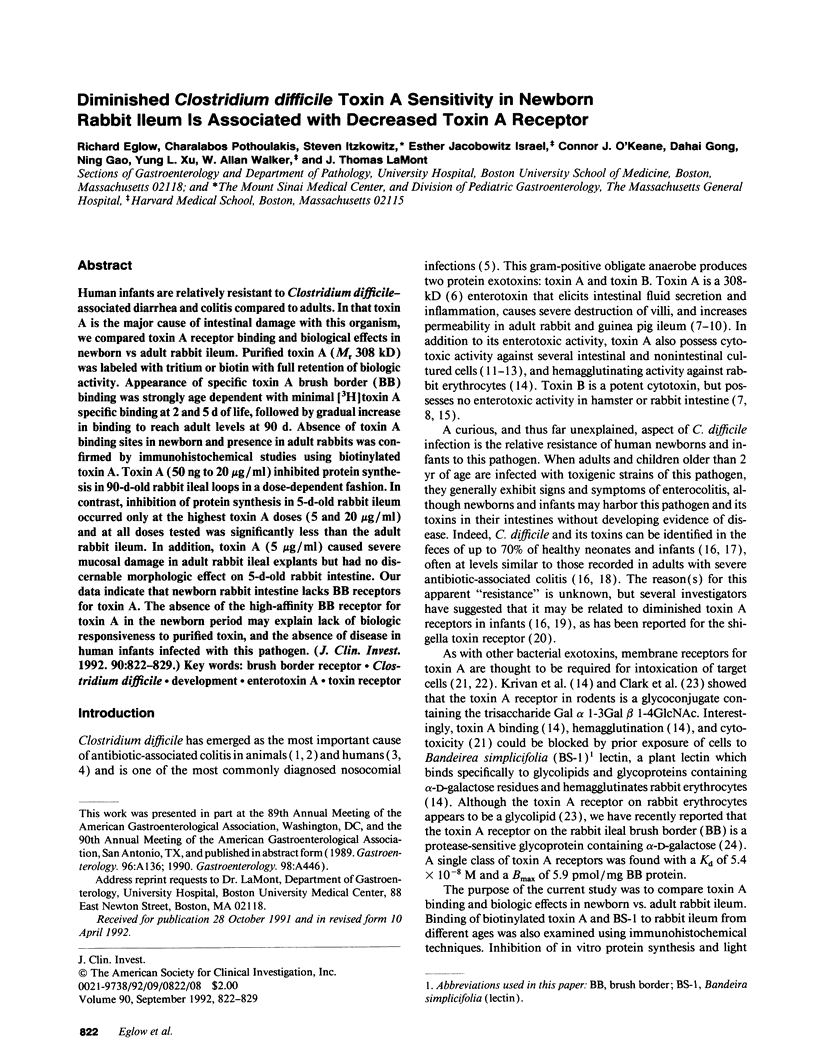
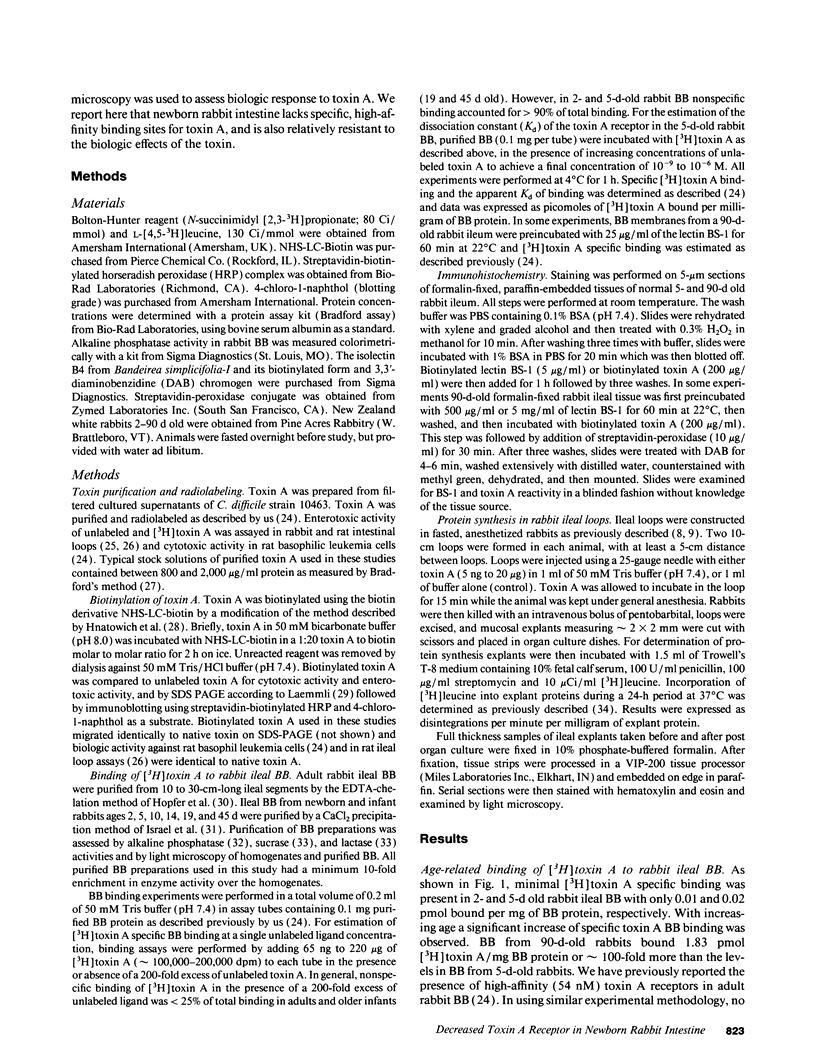
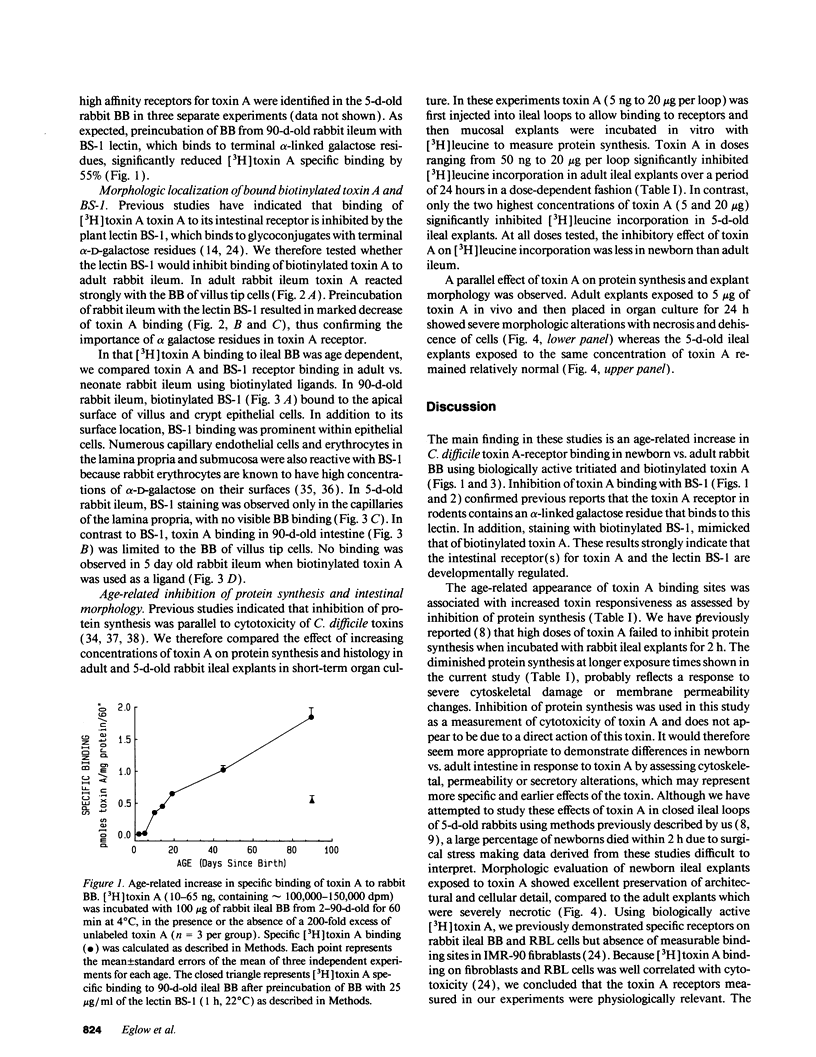



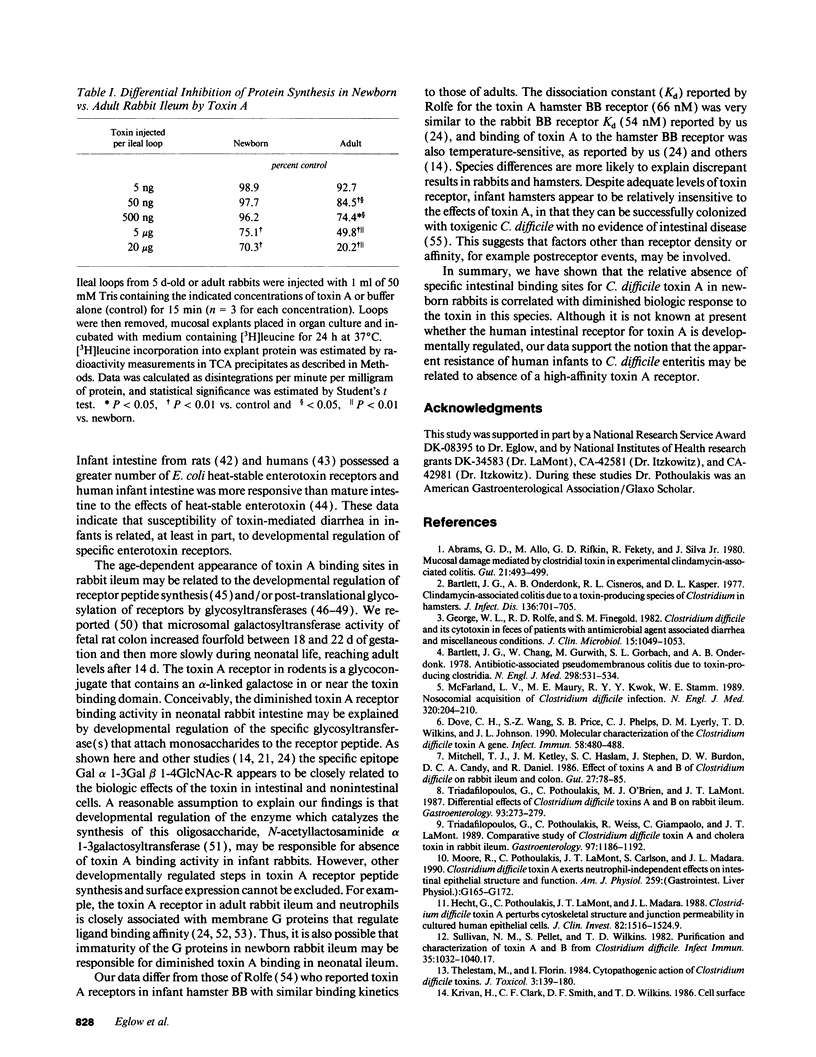
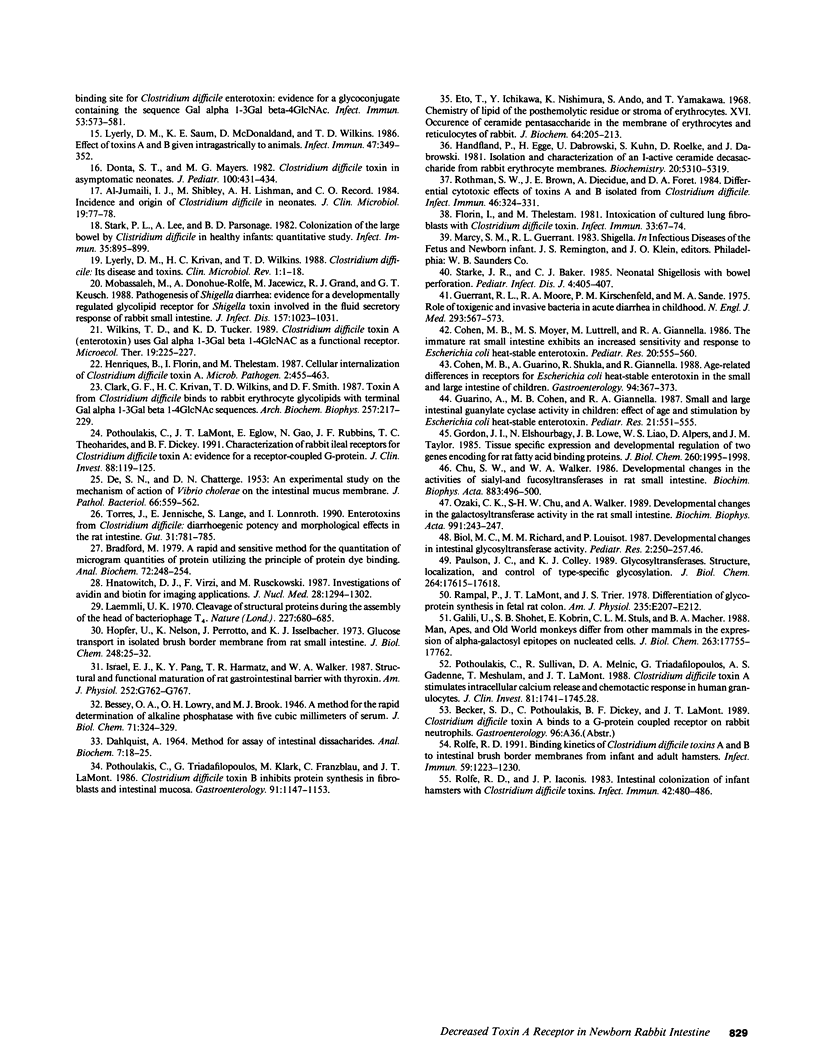
Images in this article
Selected References
These references are in PubMed. This may not be the complete list of references from this article.
- Abrams G. D., Allo M., Rifkin G. D., Fekety R., Silva J., Jr Mucosal damage mediated by clostridial toxin in experimental clindamycin-associated colitis. Gut. 1980 Jun;21(6):493–499. doi: 10.1136/gut.21.6.493. [DOI] [PMC free article] [PubMed] [Google Scholar]
- Al-Jumaili I. J., Shibley M., Lishman A. H., Record C. O. Incidence and origin of Clostridium difficile in neonates. J Clin Microbiol. 1984 Jan;19(1):77–78. doi: 10.1128/jcm.19.1.77-78.1984. [DOI] [PMC free article] [PubMed] [Google Scholar]
- Bartlett J. G., Chang T. W., Gurwith M., Gorbach S. L., Onderdonk A. B. Antibiotic-associated pseudomembranous colitis due to toxin-producing clostridia. N Engl J Med. 1978 Mar 9;298(10):531–534. doi: 10.1056/NEJM197803092981003. [DOI] [PubMed] [Google Scholar]
- Bartlett J. G., Onderdonk A. B., Cisneros R. L., Kasper D. L. Clindamycin-associated colitis due to a toxin-producing species of Clostridium in hamsters. J Infect Dis. 1977 Nov;136(5):701–705. doi: 10.1093/infdis/136.5.701. [DOI] [PubMed] [Google Scholar]
- Biol M. C., Martin A., Richard M., Louisot P. Developmental changes in intestinal glycosyl-transferase activities. Pediatr Res. 1987 Sep;22(3):250–256. doi: 10.1203/00006450-198709000-00003. [DOI] [PubMed] [Google Scholar]
- Bradford M. M. A rapid and sensitive method for the quantitation of microgram quantities of protein utilizing the principle of protein-dye binding. Anal Biochem. 1976 May 7;72:248–254. doi: 10.1016/0003-2697(76)90527-3. [DOI] [PubMed] [Google Scholar]
- Chu S. H., Walker W. A. Developmental changes in the activities of sialyl- and fucosyltransferases in rat small intestine. Biochim Biophys Acta. 1986 Oct 1;883(3):496–500. doi: 10.1016/0304-4165(86)90289-8. [DOI] [PubMed] [Google Scholar]
- Clark G. F., Krivan H. C., Wilkins T. D., Smith D. F. Toxin A from Clostridium difficile binds to rabbit erythrocyte glycolipids with terminal Gal alpha 1-3Gal beta 1-4GlcNAc sequences. Arch Biochem Biophys. 1987 Aug 15;257(1):217–229. doi: 10.1016/0003-9861(87)90561-3. [DOI] [PubMed] [Google Scholar]
- Cohen M. B., Guarino A., Shukla R., Giannella R. A. Age-related differences in receptors for Escherichia coli heat-stable enterotoxin in the small and large intestine of children. Gastroenterology. 1988 Feb;94(2):367–373. doi: 10.1016/0016-5085(88)90423-4. [DOI] [PubMed] [Google Scholar]
- Cohen M. B., Moyer M. S., Luttrell M., Giannella R. A. The immature rat small intestine exhibits an increased sensitivity and response to Escherichia coli heat-stable enterotoxin. Pediatr Res. 1986 Jun;20(6):555–560. doi: 10.1203/00006450-198606000-00017. [DOI] [PubMed] [Google Scholar]
- DAHLQVIST A. METHOD FOR ASSAY OF INTESTINAL DISACCHARIDASES. Anal Biochem. 1964 Jan;7:18–25. doi: 10.1016/0003-2697(64)90115-0. [DOI] [PubMed] [Google Scholar]
- Donta S. T., Myers M. G. Clostridium difficile toxin in asymptomatic neonates. J Pediatr. 1982 Mar;100(3):431–434. doi: 10.1016/s0022-3476(82)80454-x. [DOI] [PubMed] [Google Scholar]
- Dove C. H., Wang S. Z., Price S. B., Phelps C. J., Lyerly D. M., Wilkins T. D., Johnson J. L. Molecular characterization of the Clostridium difficile toxin A gene. Infect Immun. 1990 Feb;58(2):480–488. doi: 10.1128/iai.58.2.480-488.1990. [DOI] [PMC free article] [PubMed] [Google Scholar]
- Eto T., Ichikawa Y., Nishimura K., Ando S., Yamakawa T. Chemistry of lipid of the posthemyolytic residue or stroma of erythrocytes. XVI. Occurrence of ceramide pentasaccharide in the membrane of erythrocytes and reticulocytes of rabbit. J Biochem. 1968 Aug;64(2):205–213. doi: 10.1093/oxfordjournals.jbchem.a128881. [DOI] [PubMed] [Google Scholar]
- Florin I., Thelestam M. Intoxication of cultured human lung fibroblasts with Clostridium difficile toxin. Infect Immun. 1981 Jul;33(1):67–74. doi: 10.1128/iai.33.1.67-74.1981. [DOI] [PMC free article] [PubMed] [Google Scholar]
- Galili U., Shohet S. B., Kobrin E., Stults C. L., Macher B. A. Man, apes, and Old World monkeys differ from other mammals in the expression of alpha-galactosyl epitopes on nucleated cells. J Biol Chem. 1988 Nov 25;263(33):17755–17762. [PubMed] [Google Scholar]
- George W. L., Rolfe R. D., Finegold S. M. Clostridium difficile and its cytotoxin in feces of patients with antimicrobial agent-associated diarrhea and miscellaneous conditions. J Clin Microbiol. 1982 Jun;15(6):1049–1053. doi: 10.1128/jcm.15.6.1049-1053.1982. [DOI] [PMC free article] [PubMed] [Google Scholar]
- Gordon J. I., Elshourbagy N., Lowe J. B., Liao W. S., Alpers D. H., Taylor J. M. Tissue specific expression and developmental regulation of two genes coding for rat fatty acid binding proteins. J Biol Chem. 1985 Feb 25;260(4):1995–1998. [PubMed] [Google Scholar]
- Guarino A., Cohen M. B., Giannella R. A. Small and large intestinal guanylate cyclase activity in children: effect of age and stimulation by Escherichia coli heat-stable enterotoxin. Pediatr Res. 1987 Jun;21(6):551–555. doi: 10.1203/00006450-198706000-00009. [DOI] [PubMed] [Google Scholar]
- Guerrant R. L., Moore R. A., Kirschenfeld P. M., Sande M. A. Role of toxigenic and invasive bacteria in acute diarrhea of childhood. N Engl J Med. 1975 Sep 18;293(12):567–572. doi: 10.1056/NEJM197509182931201. [DOI] [PubMed] [Google Scholar]
- Hanfland P., Egge H., Dabrowski U., Kuhn S., Roelcke D., Dabrowski J. Isolation and characterization of an I-active ceramide decasaccharide from rabbit erythrocyte membranes. Biochemistry. 1981 Sep 1;20(18):5310–5319. doi: 10.1021/bi00521a034. [DOI] [PubMed] [Google Scholar]
- Hecht G., Pothoulakis C., LaMont J. T., Madara J. L. Clostridium difficile toxin A perturbs cytoskeletal structure and tight junction permeability of cultured human intestinal epithelial monolayers. J Clin Invest. 1988 Nov;82(5):1516–1524. doi: 10.1172/JCI113760. [DOI] [PMC free article] [PubMed] [Google Scholar]
- Henriques B., Florin I., Thelestam M. Cellular internalisation of Clostridium difficile toxin A. Microb Pathog. 1987 Jun;2(6):455–463. doi: 10.1016/0882-4010(87)90052-0. [DOI] [PubMed] [Google Scholar]
- Hnatowich D. J., Virzi F., Rusckowski M. Investigations of avidin and biotin for imaging applications. J Nucl Med. 1987 Aug;28(8):1294–1302. [PubMed] [Google Scholar]
- Hopfer U., Nelson K., Perrotto J., Isselbacher K. J. Glucose transport in isolated brush border membrane from rat small intestine. J Biol Chem. 1973 Jan 10;248(1):25–32. [PubMed] [Google Scholar]
- Israel E. J., Pang K. Y., Harmatz P. R., Walker W. A. Structural and functional maturation of rat gastrointestinal barrier with thyroxine. Am J Physiol. 1987 Jun;252(6 Pt 1):G762–G767. doi: 10.1152/ajpgi.1987.252.6.G762. [DOI] [PubMed] [Google Scholar]
- Krivan H. C., Clark G. F., Smith D. F., Wilkins T. D. Cell surface binding site for Clostridium difficile enterotoxin: evidence for a glycoconjugate containing the sequence Gal alpha 1-3Gal beta 1-4GlcNAc. Infect Immun. 1986 Sep;53(3):573–581. doi: 10.1128/iai.53.3.573-581.1986. [DOI] [PMC free article] [PubMed] [Google Scholar]
- Laemmli U. K. Cleavage of structural proteins during the assembly of the head of bacteriophage T4. Nature. 1970 Aug 15;227(5259):680–685. doi: 10.1038/227680a0. [DOI] [PubMed] [Google Scholar]
- Lyerly D. M., Saum K. E., MacDonald D. K., Wilkins T. D. Effects of Clostridium difficile toxins given intragastrically to animals. Infect Immun. 1985 Feb;47(2):349–352. doi: 10.1128/iai.47.2.349-352.1985. [DOI] [PMC free article] [PubMed] [Google Scholar]
- McFarland L. V., Mulligan M. E., Kwok R. Y., Stamm W. E. Nosocomial acquisition of Clostridium difficile infection. N Engl J Med. 1989 Jan 26;320(4):204–210. doi: 10.1056/NEJM198901263200402. [DOI] [PubMed] [Google Scholar]
- Mitchell T. J., Ketley J. M., Haslam S. C., Stephen J., Burdon D. W., Candy D. C., Daniel R. Effect of toxin A and B of Clostridium difficile on rabbit ileum and colon. Gut. 1986 Jan;27(1):78–85. doi: 10.1136/gut.27.1.78. [DOI] [PMC free article] [PubMed] [Google Scholar]
- Mobassaleh M., Donohue-Rolfe A., Jacewicz M., Grand R. J., Keusch G. T. Pathogenesis of shigella diarrhea: evidence for a developmentally regulated glycolipid receptor for shigella toxin involved in the fluid secretory response of rabbit small intestine. J Infect Dis. 1988 May;157(5):1023–1031. doi: 10.1093/infdis/157.5.1023. [DOI] [PubMed] [Google Scholar]
- Moore R., Pothoulakis C., LaMont J. T., Carlson S., Madara J. L. C. difficile toxin A increases intestinal permeability and induces Cl- secretion. Am J Physiol. 1990 Aug;259(2 Pt 1):G165–G172. doi: 10.1152/ajpgi.1990.259.2.G165. [DOI] [PubMed] [Google Scholar]
- Ozaki C. K., Chu S. H., Walker W. A. Developmental changes in galactosyltransferase activity in the rat small intestine. Biochim Biophys Acta. 1989 May 31;991(2):243–247. doi: 10.1016/0304-4165(89)90111-6. [DOI] [PubMed] [Google Scholar]
- Paulson J. C., Colley K. J. Glycosyltransferases. Structure, localization, and control of cell type-specific glycosylation. J Biol Chem. 1989 Oct 25;264(30):17615–17618. [PubMed] [Google Scholar]
- Pothoulakis C., LaMont J. T., Eglow R., Gao N., Rubins J. B., Theoharides T. C., Dickey B. F. Characterization of rabbit ileal receptors for Clostridium difficile toxin A. Evidence for a receptor-coupled G protein. J Clin Invest. 1991 Jul;88(1):119–125. doi: 10.1172/JCI115267. [DOI] [PMC free article] [PubMed] [Google Scholar]
- Pothoulakis C., Sullivan R., Melnick D. A., Triadafilopoulos G., Gadenne A. S., Meshulam T., LaMont J. T. Clostridium difficile toxin A stimulates intracellular calcium release and chemotactic response in human granulocytes. J Clin Invest. 1988 Jun;81(6):1741–1745. doi: 10.1172/JCI113514. [DOI] [PMC free article] [PubMed] [Google Scholar]
- Pothoulakis C., Triadafilopoulos G., Clark M., Franzblau C., LaMont J. T. Clostridium difficile cytotoxin inhibits protein synthesis in fibroblasts and intestinal mucosa. Gastroenterology. 1986 Nov;91(5):1147–1153. doi: 10.1016/s0016-5085(86)80010-5. [DOI] [PubMed] [Google Scholar]
- Rampal P., LaMont J. T., Trier J. S. Differentiation of glycoprotein synthesis in fetal rat colon. Am J Physiol. 1978 Aug;235(2):E207–E212. doi: 10.1152/ajpendo.1978.235.2.E207. [DOI] [PubMed] [Google Scholar]
- Rolfe R. D. Binding kinetics of Clostridium difficile toxins A and B to intestinal brush border membranes from infant and adult hamsters. Infect Immun. 1991 Apr;59(4):1223–1230. doi: 10.1128/iai.59.4.1223-1230.1991. [DOI] [PMC free article] [PubMed] [Google Scholar]
- Rolfe R. D., Iaconis J. P. Intestinal colonization of infant hamsters with Clostridium difficile. Infect Immun. 1983 Nov;42(2):480–486. doi: 10.1128/iai.42.2.480-486.1983. [DOI] [PMC free article] [PubMed] [Google Scholar]
- Rothman S. W., Brown J. E., Diecidue A., Foret D. A. Differential cytotoxic effects of toxins A and B isolated from Clostridium difficile. Infect Immun. 1984 Nov;46(2):324–331. doi: 10.1128/iai.46.2.324-331.1984. [DOI] [PMC free article] [PubMed] [Google Scholar]
- Stark P. L., Lee A., Parsonage B. D. Colonization of the large bowel by Clostridium difficile in healthy infants: quantitative study. Infect Immun. 1982 Mar;35(3):895–899. doi: 10.1128/iai.35.3.895-899.1982. [DOI] [PMC free article] [PubMed] [Google Scholar]
- Starke J. R., Baker C. J. Neonatal shigellosis with bowel perforation. Pediatr Infect Dis. 1985 Jul-Aug;4(4):405–407. doi: 10.1097/00006454-198507000-00016. [DOI] [PubMed] [Google Scholar]
- Sullivan N. M., Pellett S., Wilkins T. D. Purification and characterization of toxins A and B of Clostridium difficile. Infect Immun. 1982 Mar;35(3):1032–1040. doi: 10.1128/iai.35.3.1032-1040.1982. [DOI] [PMC free article] [PubMed] [Google Scholar]
- Torres J., Jennische E., Lange S., Lönnroth I. Enterotoxins from Clostridium difficile; diarrhoeogenic potency and morphological effects in the rat intestine. Gut. 1990 Jul;31(7):781–785. doi: 10.1136/gut.31.7.781. [DOI] [PMC free article] [PubMed] [Google Scholar]
- Triadafilopoulos G., Pothoulakis C., O'Brien M. J., LaMont J. T. Differential effects of Clostridium difficile toxins A and B on rabbit ileum. Gastroenterology. 1987 Aug;93(2):273–279. doi: 10.1016/0016-5085(87)91014-6. [DOI] [PubMed] [Google Scholar]
- Triadafilopoulos G., Pothoulakis C., Weiss R., Giampaolo C., Lamont J. T. Comparative study of Clostridium difficile toxin A and cholera toxin in rabbit ileum. Gastroenterology. 1989 Nov;97(5):1186–1192. doi: 10.1016/0016-5085(89)91689-2. [DOI] [PubMed] [Google Scholar]






